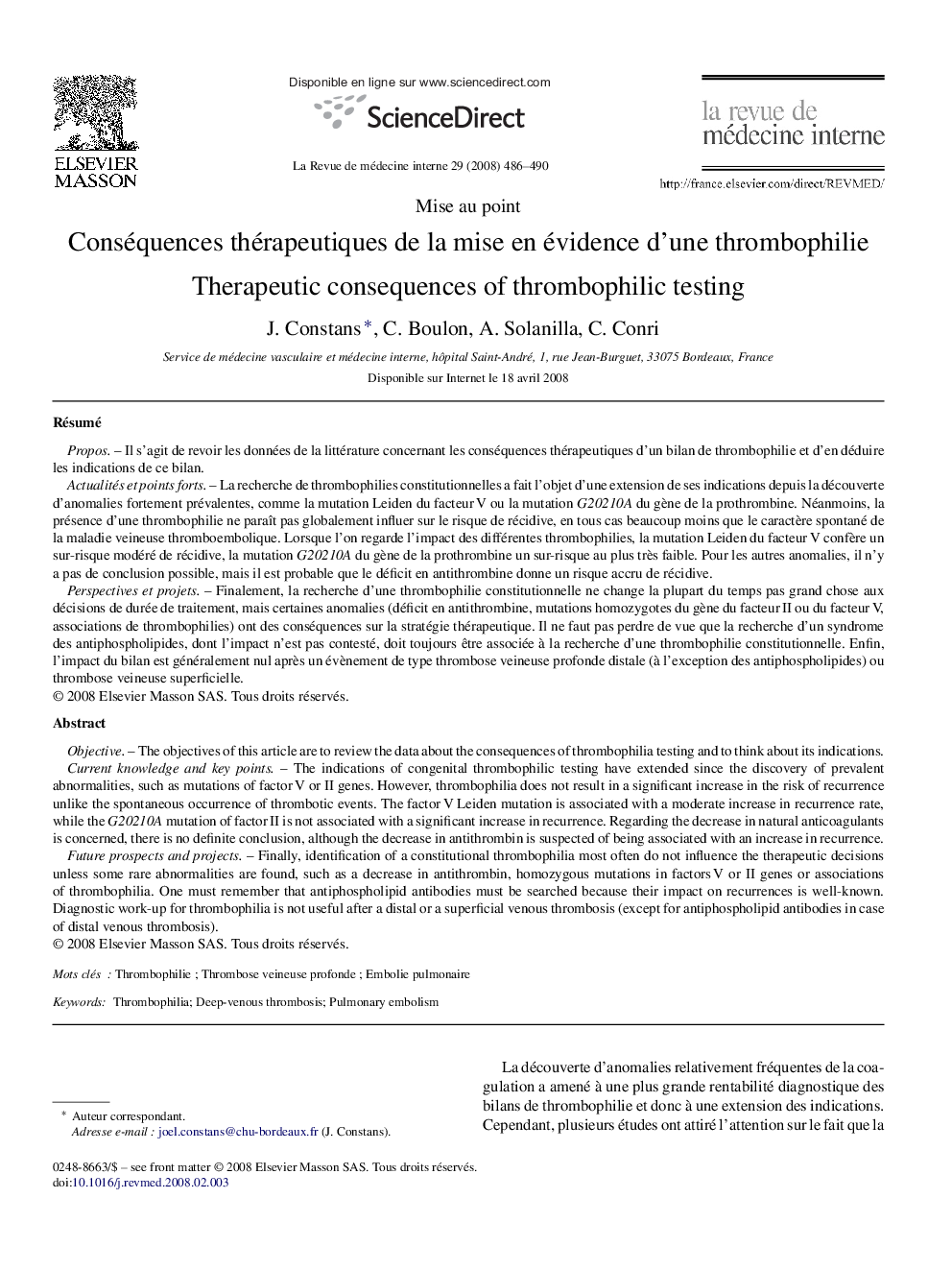| کد مقاله | کد نشریه | سال انتشار | مقاله انگلیسی | نسخه تمام متن |
|---|---|---|---|---|
| 3024086 | 1182508 | 2008 | 5 صفحه PDF | دانلود رایگان |

RésuméProposIl s’agit de revoir les données de la littérature concernant les conséquences thérapeutiques d’un bilan de thrombophilie et d’en déduire les indications de ce bilan.Actualités et points fortsLa recherche de thrombophilies constitutionnelles a fait l’objet d’une extension de ses indications depuis la découverte d’anomalies fortement prévalentes, comme la mutation Leiden du facteur V ou la mutation G20210A du gène de la prothrombine. Néanmoins, la présence d’une thrombophilie ne paraît pas globalement influer sur le risque de récidive, en tous cas beaucoup moins que le caractère spontané de la maladie veineuse thromboembolique. Lorsque l’on regarde l’impact des différentes thrombophilies, la mutation Leiden du facteur V confère un sur-risque modéré de récidive, la mutation G20210A du gène de la prothrombine un sur-risque au plus très faible. Pour les autres anomalies, il n’y a pas de conclusion possible, mais il est probable que le déficit en antithrombine donne un risque accru de récidive.Perspectives et projetsFinalement, la recherche d’une thrombophilie constitutionnelle ne change la plupart du temps pas grand chose aux décisions de durée de traitement, mais certaines anomalies (déficit en antithrombine, mutations homozygotes du gène du facteur II ou du facteur V, associations de thrombophilies) ont des conséquences sur la stratégie thérapeutique. Il ne faut pas perdre de vue que la recherche d’un syndrome des antiphospholipides, dont l’impact n’est pas contesté, doit toujours être associée à la recherche d’une thrombophilie constitutionnelle. Enfin, l’impact du bilan est généralement nul après un évènement de type thrombose veineuse profonde distale (à l’exception des antiphospholipides) ou thrombose veineuse superficielle.
ObjectiveThe objectives of this article are to review the data about the consequences of thrombophilia testing and to think about its indications.Current knowledge and key pointsThe indications of congenital thrombophilic testing have extended since the discovery of prevalent abnormalities, such as mutations of factor V or II genes. However, thrombophilia does not result in a significant increase in the risk of recurrence unlike the spontaneous occurrence of thrombotic events. The factor V Leiden mutation is associated with a moderate increase in recurrence rate, while the G20210A mutation of factor II is not associated with a significant increase in recurrence. Regarding the decrease in natural anticoagulants is concerned, there is no definite conclusion, although the decrease in antithrombin is suspected of being associated with an increase in recurrence.Future prospects and projectsFinally, identification of a constitutional thrombophilia most often do not influence the therapeutic decisions unless some rare abnormalities are found, such as a decrease in antithrombin, homozygous mutations in factors V or II genes or associations of thrombophilia. One must remember that antiphospholipid antibodies must be searched because their impact on recurrences is well-known. Diagnostic work-up for thrombophilia is not useful after a distal or a superficial venous thrombosis (except for antiphospholipid antibodies in case of distal venous thrombosis).
Journal: La Revue de Médecine Interne - Volume 29, Issue 6, June 2008, Pages 486–490